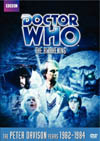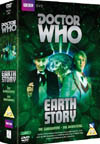The Awakening
 |
 |
 |
DVD NTSC
Region 1




|
DVD PAL
Region 2
Box Set


|
VHS Video
NTSC
 A A

NTSC
 B B

PAL


|
|
(Doctor Who Story No. 132, starring Peter Davison)
- written by Eric Pringle
- directed by Michael Owen Morris
- produced by John Nathan-Turner
- music by Peter Howell
- 2 episodes @ 25 minutes each
|
Story: Hoping to visit with Tegan's
grandfather in 1984, the Doctor and friends discover
the village of Little Hodcombe in the midst of
recreating their civil war battle of 1643.
What is causing the war games' instigator Sir George
to encourage excessive over-zealousness in the townsfolk?
What is the meaning of the many bizarre haunting apparitions
appearing all over the village? And who or what is about
to be re-awakened from within the church walls?
|
|
DVD Extras include:
- Audio commentary by director Michael Owen Morris,
script editor Eric Saward,
and moderator Toby Hadoke.
- "Return to Little Hodcombe" on-location retrospective making-of
featurette (19 min.),
adding Janet Fielding (Tegan),
Keith Jayne (Will Chandler), and the locals...
- "Making the Malus" prop featurette (7 min.) with
visual effects designer Tony Harding and
modelmaker Richard Gregory.
- Peter Davison (The Doctor) receives a Golden Egg Award
for the story's spectacular news-making blooper (2 min.)
- Now & Then location featurette (7 min.)
- Deleted and Extended Scenes (9 min.)
- Isolated music score by Peter Howell
- Pop-up Production Note Subtitles
- Photo Gallery
In-Depth Analysis Review
by Martin Izsak
|
|
WARNING: This review contains "SPOILERS", and is intended for
those who have
already seen the program. To avoid the spoilers,
read the Buyers' Guide version instead.
|
Nestled cosily up near the beginning of season 21, this is one of
Peter Davison's more obscure adventures. Featuring some of the year's
best production values, and a fast pace that rivals the new millennium
version of the show, the story still doesn't quite make its way into the
highest ranks, and may indeed leave its audiences wondering after the
fact just what it was really all about.
At its core, it seems to want to tackle themes and subject matter
similar to "Snakedance" (story no. 125),
or even the Star Trek original series'
third season episode "Day of the Dove", with a psychic creature attempting
to feed off of the violent & fearful energy of other beings close by.
But the story suffers a number of holes in character motivation, the
biggest of which drains almost all believability out of the premise itself.
Instead of harnessing emotionally real conflict such as
the bitter Federation/Klingon rivalries in "Day of the Dove",
or here the actual 1643 English civil war battle, the Malus creature
in "The Awakening" attempts to utilize a 1984 mock-up, and it never
really is made clear why participants on either side of this recreation
would take it to the extremes that would generate the emotional energy
the creature needs. How do you get a whole village to agree to suspend
their regular lives for several days or more, and pretend
they're all living as they would have 340 years ago? That's enough of
a stretch. Getting them to go so far as to start killing each other
is completely unbelievable. "Day of the Dove" partly solved this
by showing that its creature was capable of inserting false memories
into its victims (Chekov most memorably), to help fuel their ferocity.
The civil war recreation aspects of the story are really upstaged by the
extremely successful creepy atmosphere surrounding the story's many
scenes featuring bizarrely different apparitions and inexplicable phenomena.
The story might have held together much better if it had, as in
"Snakedance", let the people's fear of these manifestations fuel
the creature's psychic energy needs. Indeed, one has to wonder as the
backstory comes out, how the Malus didn't achieve a more successful
awakening during the actual civil war battle in 1643. If it couldn't manage
it then, surely it doesn't stand a chance now.
Many of these considerations only come up in the last quarter of the story,
since earlier portions still work well while holding the premise back
as part of the mystery that needs to be solved. The Doctor is kept
very busy as a lead investigator in this tale, amongst the other good
quality story beats he is engaged in. Both Tegan and Turlough split off
on their own adventures for much of this, allowing Will Chandler
and more significantly Jane Hampden to fill in as pseudo companions,
with Jane fulfilling the typical function of pulling answers out of the
Doctor to help the audience understand what's going on. Many of the
connections between this story and
"The Visitation" (story no. 120) turn out
to be a really nice touch.
The Jane Hampden character also gets a few nice pseudo-companion bits of
business concerning the function of the new red handle
on the new TARDIS console, making definitive the idea that it
operates the main door, just as Nyssa had done for the old console in
"Castrovalva" (story no. 117). Nice,
and very hard to miss. The TARDIS isn't otherwise presented
in an absolutely ideal way for new viewers, but they may well get the hang
of it before the end of the story, and/or decide they want to stick around
for more of it in the next one.
The Doctor also becomes busily engaged in problem-solving mode in the
story's final scenes, which is great. What may be somewhat lost on viewers
is the idea that most of the defeat of the Malus is achieved by the Doctor
pressing some buttons in the TARDIS. But the final fix needs to occur
during the confrontation with Sir George, and as far as tying this part
into the story's premise goes, what we get on screen is a bit of a mess.
We don't get the brilliance of finding a center of stillness within oneself,
or of turning the situation around to a mood of camaraderie and good cheer.
It totally remains the sort of tense conflict that would fuel the creature,
seriously undermining the obvious thematic point that the story should have
been aiming for, substituting a silly bit of
passive-aggressive syndrome
for Will. And bizarre too is the assumption that Sir George is dead,
when he's simply shown to safely fall behind what's left of a wall
into a bit of harmless smoke. You would have thought someone might want to
help him out of the church before it collapses on him.
But so much of the rest of this story works, and it proceeds with
a pace and energy that covers over most of the other holes. Director
Michael Owen Morris is on form, and the story features lots of enjoyable
location shooting in good weather. And with such a fast pace and so much
movement on screen, it is difficult to memorize and get bored of during
repeat viewing. Indeed, had some of these action beats made their way into
"Snakedance", perhaps that story would be more widely and easily acknowledged
as Davison's best.
Daves Chapman and Jervis work together to do video effects on this story,
and achieve a lot of really neat stuff for the various apparitions. Perhaps
this work is helped by the fact that their effects are usually presented
as mysteries when they appear, meaning that the audience isn't dragging
expectations into the experience that aren't being met, as would be the
case with missing lasers.....
|
After having done both of the previous Mara stories,
composer Peter Howell should be on familiar footing tackling this story's
subject matter, yet he manages to create a very unique haunting sound
for this story, and plays a lot of little tunes that should be familiar
and bright, but are just "off" enough to creep one out instead.
Very cool. Music is a really effective element giving this story its
superb atmosphere.
|
Music by Peter Howell
A suite of 3:26 duration is available on:
|
|
It's interesting to note how this is very nearly another story
well outside the Black Guardian trilogy that wants to lock
Turlough up in the first episode and not let him out until the last.
Technically, the scene of Turlough getting caught had to be shifted
into Part Two because Part One was running long. However, despite
a magazine quote in which Mark Strickson complains that he spent the
whole story being locked up, Turlough's bout of the prisoner dynamic
is quite short here, and alleviated by the fact that he brings out some
important information for the plot while he is in it. It's a far better
showing for him here than back in
"The King's Demons" (story no. 129).
Interestingly, Kamelion was originally written into a small scene
in the beginning, and videotaped as well, but this was trimmed for time.
Unfortunately, it's not very easy to recognize Peter Davison's or
Mark Strickson's voices as Kamelion "borrows" them, making it harder
for the audience to be on the same page with Tegan's responses as
we were probably meant to be. Thanks to the DVD, we can now
check out this and many other deleted & extended scenes & sequences.
I almost suspect that, had the character motivations been brought up
to work with this story's premise, it might have been the gem of the season.
However, this is much too important a thing to miss, particularly during
the concluding moves, and "The Awakening" probably won't be able to
climb too high in the rankings as it stands. It remains highly enjoyable
however, and speaks loudly of the generally exciting quality of
season 21.
International Titles:
Magyar: "Az ébredés"
Français: (Le réveil)
Русский: "Пробуждение"
This story is available on DVD and VHS video:
 |
 |
 |
DVD NTSC Region 1
for the North American market:

 in the U.S.
in the U.S.

 in Canada
in Canada
|
DVD PAL Region 2
Box Set

 for the U.K.
for the U.K.
|
VHS Video
NTSC
 A A
 for North America
for North America
NTSC
 B B
 for North America
for North America
PAL

 in the U.K.
in the U.K.
|
Comments on this article are welcome. You may contact
the author from this page:
Contact page

LYRATEK.COM
|
Read the In-depth Analysis Review for the next story:
"Frontios"

|
|









